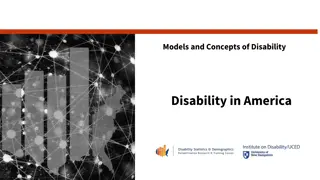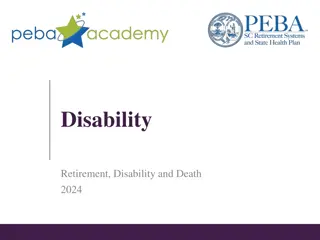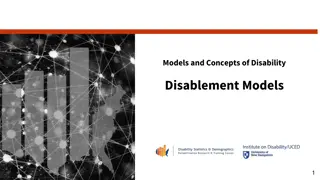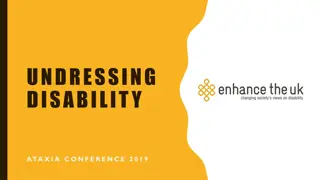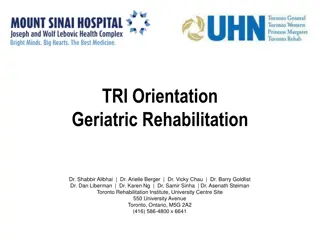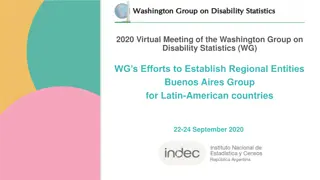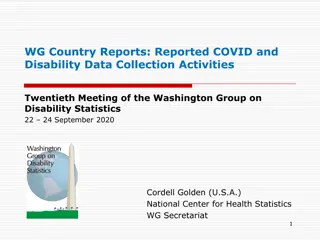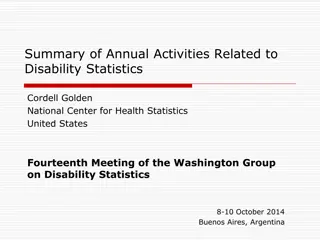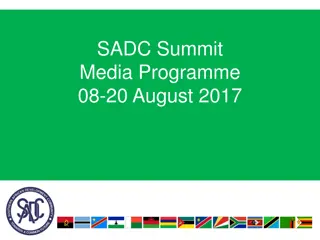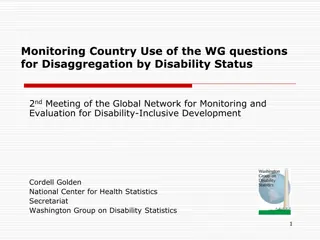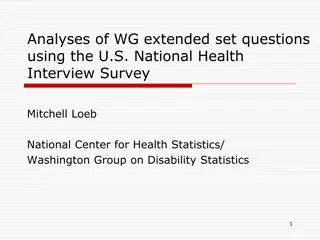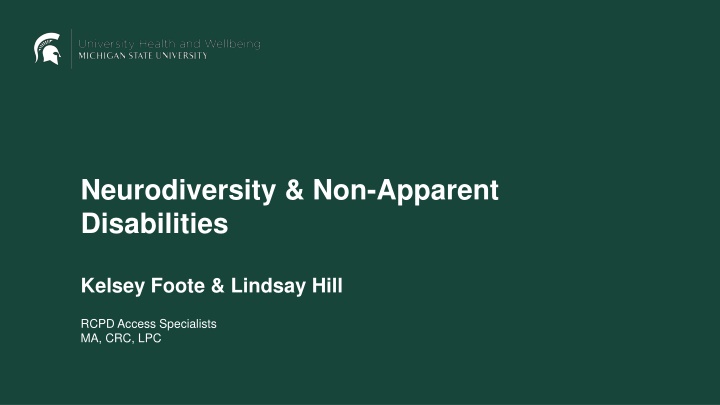
Neurodiversity, Non-Apparent Disabilities, and Neurodivergence
Explore the concepts of neurodiversity, non-apparent disabilities, and neurodivergence, shedding light on the variations in brain functioning and the challenges faced by individuals with conditions like autism, ADHD, and dyslexia. Learn about the complexities of invisible disabilities and the importance of embracing diversity in brain function.
Download Presentation

Please find below an Image/Link to download the presentation.
The content on the website is provided AS IS for your information and personal use only. It may not be sold, licensed, or shared on other websites without obtaining consent from the author. If you encounter any issues during the download, it is possible that the publisher has removed the file from their server.
You are allowed to download the files provided on this website for personal or commercial use, subject to the condition that they are used lawfully. All files are the property of their respective owners.
The content on the website is provided AS IS for your information and personal use only. It may not be sold, licensed, or shared on other websites without obtaining consent from the author.
E N D
Presentation Transcript
Neurodiversity & Non-Apparent Disabilities Kelsey Foote & Lindsay Hill RCPD Access Specialists MA, CRC, LPC
Disclaimer! This is just an introduction
Non-Apparent Disabilities Many mental health, neurological, learning and chronic health-related disabilities are non-apparent to the casual observer. People with these disabilities often experience additional ableism for several reasons Examples of non-apparent disabilities: autism, depression, diabetes, and learning and thinking differences such as ADHD and dyslexia. Non-apparent disabilities can also include symptoms such as chronic pain, fatigue, and dizziness. Why "non-apparent" instead of "invisible"? o not all apparent disabilities are visible o disabilities that have been labeled as "invisible" such as anxiety, depression, etc. may become visible when someone is experiencing heightened impacts like a panic attack o by using labels such as "apparent" and "non-apparent," there is more room for understanding disability as a fluid experience that ebbs and flows.
Neurodiversity & Neurodivergence Neurodiversity Individual differences in brain functioning regarded as normal variations within the human population. Differences should not be stigmatized. Variations are not seen as deficits. Overall: the concept of diversity, applied to how our brains function. Think: "biodiversity" Neurodivergent (ND) Describes people whose brains are significantly different to what is expected in the typical population. Differences might be innate (e.g., autism) or acquired (e.g., brain injury), and include medical conditions(e.g., epilepsy), mental health conditions (e.g., trauma), learning disabilities (e.g., dyslexia) and other neurodevelopmental conditions (e.g., ADHD). Neurotypical: societal standard of "normal" functioning
Common Neurodivergence Oftentimes, "neurodivergence" refers to the diagnoses of ADHD, autism, and learning disabilities. However, there are many other conditions that fall under this definition. Folks can use this way of identifying themselves or not! https://www.livedexperienceeducator.com/
Medical Model of Disability Labeling diagnoses originated from the medical model of disability: disability is something "wrong" to be treated/"fixed" There are MANY people who consider themselves/would be considered neurodivergent who don't have a medical diagnosis for a variety of reasons o lack of access to healthcare/resources for obtaining a diagnosis, family/cultural belief systems, not wanting a "label", not having access to information about neurodivergence, doing "too well" in school to be noticed by special education services
Neurodivergence at RCPD 78% 78% This is the rough percentage of RCPD students registered with neurodivergence definitely an underestimate!
Strength in Neurodiversity Like diversity in any sense, neurodiversity provides us with valuable and needed differences in thought processes and problem solving. This Photo by Unknown author is licensed under CC BY.
Strengths of Neurodivergence Many see neurodivergence as a collection of deficits. However, there are endless strengths to consider... Creativity Resilience Attention to detail Depth of thought Memory Empathy Passion
Common Impacts of Neurodivergence Executive Dysfunction Tangential thinking Working memory deficits Time management/organization Distractibility Lack of awareness/self-awareness Emotion regulation Concentration/focus Planning Communication Social interactions Stress management Motivation BUT .
Thinking about impacts as differences, not deficits Impacts of nonapparent disabilities/neurodivergence tend to be seen negatively by others because we are looking from a pathology lens (where the ideal outcome is compliance) and from a neuronormative lens where we prioritize the neurotypical experience From a neurodiversity lens, people should get to decide what is functional and dysfunctional o There is not one right way to be/to do things. Executive functioning skills and brain/body function are a spectrum.
Sonny Jane Wise (they/them) @livedexperienceeducator Sonny Jane Wise [@livedexperienceeducator]. Photo series of quotes related to executive functioning. Instagram. 12 September 2024, https://www.instagram.com/p/C_1wqv1Sukv/?igsh=MWw5b3FnZHU0ZzAzcw==
Sonny Jane Wise cont. "I'm not saying our challenges with executive functioning aren t disabling, because they are, but I am saying that lacking certain EF skills doesn t mean there's something biologically wrong with our brains" "Understanding how executive functioning skills are actually a set of rules shaped by white supremacy has allowed me to shift the blame from myself and instead, accommodate my differences without viewing them as personal failings" Sonny Jane Wise [@livedexperienceeducator]. Photo series of quotes related to executive functioning. Instagram. 12 September 2024, https://www.instagram.com/p/C_1wqv1Sukv/?igsh =MWw5b3FnZHU0ZzAzcw==
Language Matters! Person first vs. Identity first language Identity is decided individually. As are communication preferences. Listen to the person you are talking to!
Language Matters (2) General language: the words disability and disabled are okay to use! Trying to dance around the words by saying differently abled , special needs , (dis)Ability , mentally/physically challenged is usually offensive and can promote bias. Avoid making up words to describe disability. High functioning or low functioning are outdated and can be offensive. What to say instead? access needs Saying someone suffers from a condition places judgment. Just because someone has a disability doesn t mean they are suffering. Think about common language you might use and how it can be stigmatizing: she s a psycho , that s crazy , wheelchair bound , I m so OCD When it s relevant: ASK preferences! MSU Brand Studio has an inclusive guide, including disability info/terminology!
Considerations for Neurodivergent & Non-apparent Disability Experiences Masking: changing behavior, communication style, etc. to conform to neurotypical standards Burnout Chronic stress Communication/social difficulties Sensory sensitivities
Culture (1) Universal design: truly inclusive environment may mean that some accommodations aren't needed, but this doesn't negate all accommodations! For example: always using a microphone/captions, ensuring accessible events & documents, monitoring environment for extremes (temperature, sound, light, etc.), allowing adequate processing time during presentations/conversations Scheduling: offer as much notice/info as possible and have policies for emergency situations. Surprise meetings, after hours communications about office closures, and meetings without context can cause stress and confusion. Mandatory "fun": make it flexible and opt-in! Give LOTS of info in advance. Dress codes: what's necessary and why? Can there be flexibility? Individuals may have sensory concerns or difficulty understanding norms. Toxic positivity: an environment where showing signs of weakness or asking for help is taboo. Demonstrate and encourage honest communication and normalize emotional responses. Neurodivergent folks may have specific impacts related to emotional regulation and understanding social communication.
Culture (2) Flexibility is good for everyone! Think: disabled people, parents, caregivers. Consistency is important for many neurodivergent folks BUT executive functioning impacts may require flexibility. Use inclusive language: identity-first and person-first are both common. Don't use disability diagnoses or neurodivergent traits to describe behaviors ("I'm so ADHD today!"). Listen! To neurodivergent folks. "Just try harder" is not good advice, but we hear it all the time Educate yourself on neurodivergent/non-apparent conditions and accessibility. Never make assumptions about skills/personality/abilities/etc. based on a diagnosis. Confront assumptions or stigma you might hold. What has shaped your thoughts on disability and neurodivergence? How can you actively change those thought patterns? Remember, just because something has always been done a certain way, doesn't mean it has to stay that way.

